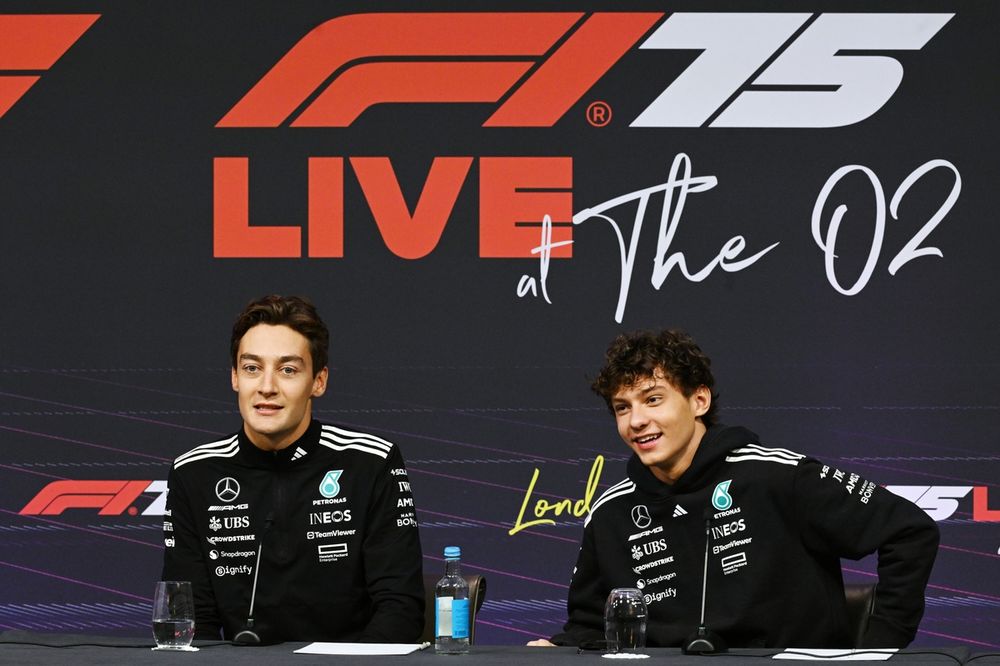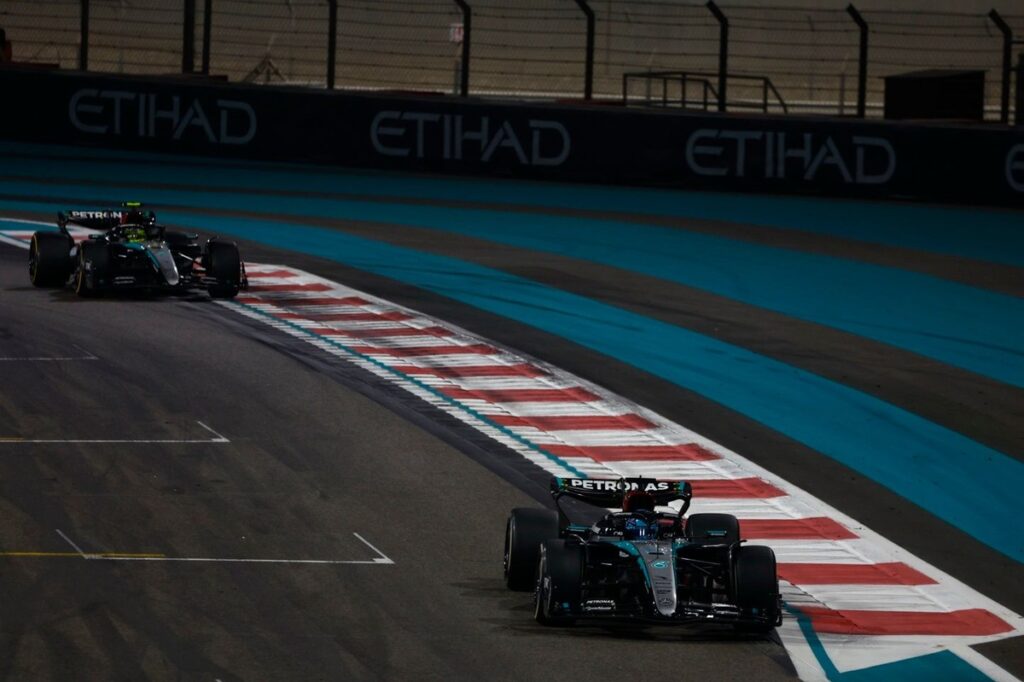Ever since Formula 1 reintroduced ground-effect underbody aerodynamics into its ruleset, Mercedes has unwittingly ensconced itself within the pitfalls that the aero overhaul had laid out.
A series of design direction changes over the past three years have brought glimmers of hope with each new car, but in each time Mercedes has tripped itself up with inconsistencies in car characteristics.
The Brackley squad is hoping that bad luck, per the general consensus, comes in threes; George Russell believes that the incoming W16 – due to be launched prior to the Bahrain pre-season test – should clear any of the “traps” of which the team has previously fallen foul.
At F1’s 75th anniversary launch event, Russell explained that the team had perhaps been guilty of becoming too blinkered by solving the problems that had become apparent, with limited foresight into the consequences that any design changes had.
This stretches back to its problematic W13, its first iteration of machinery developed for the current generation of cars. As Russell explained, the team “couldn’t unpick what was bouncing and what were poor characteristics within the car”, leading to a lengthy battle against the 2022 car’s propensity to unlock its natural heave frequency in spine-shattering fashion.
The team then decided that its slimline sidepods were not the way to go, instead opting for a more conventional set of sidepods part-way through the follow-up W14’s development process in 2023.
George Russell, Mercedes W13
Photo by: Carl Bingham / Motorsport Images
Once it had seemed to solve that through changing the car’s aerodynamic properties, it found that its suspension layout was not conducive to getting the most out of the underbody aero and the team spent that year running the car slightly higher up versus its rivals.
It felt empowered to run the car lower in 2024, having worked on that suspension issue – but Russell then noted that this produced a knock-on effect of inducing inconsistent balance.
“These things, it does just take time,” Russell explained. “And I think when something clicks and something works, you sometimes also don’t know quite why that is – we went to Vegas last year and dominated.
“I’d love to tell you exactly why that is. We’ve got some ideas why that could be, but there’s not like a silver bullet saying that is the reason why we were so strong there, and the reason we were so weak elsewhere. But I think that’s the case with everyone – even McLaren, prime example: I don’t think even they believed they could find performance that they did.
“It’s just all got to work together. But I’m much more confident we’re not going to fall into a trap as we have in the previous years.”
With infinite time, engineering a solution to a problem should come with an exploration of its side-effects. F1 teams don’t have that luxury; lead times are short and expectations are of an immediate fix.
That lends credence to Russell’s assertion that “we’ve been so focused on solving the problem, we weren’t looking ahead to what future issues it would cause”. Think of it like Whack-A-Mole – you knock one mole down, and another springs up…

George Russell, Mercedes, Andrea Kimi Antonelli, Mercedes
Photo by: Getty Images
There is anecdotal evidence of the simulation tools that F1 teams use not showing the full picture; given the restriction of wind tunnel scales and air speeds, allied to the lack of testing under completely realistic conditions, certain flaws are glossed over by the data.
Can a team realistically build a fully complete aero map if a wind tunnel or CFD simulation can’t allow for a car to yaw at 200mph? Certainly not. It can offer hints, but a car’s characteristics are dynamic and thus issues can sometimes only crop up when it hits the circuit in anger.
For Mercedes, 2025 will need to be an exercise in broadening the engineers’ minds beyond the original face-value issues. If it changes the suspension characteristics, how will that affect the chassis response? How will it affect the aero balance? Do more problems appear as a result?
It’s not that Mercedes hasn’t considered all of those things but, in trying to press a solution in place, perhaps the thinking is that it might be able to mitigate whatever consequences occur with set-up – only, to find out that they’re issues that require more attention than a bit of extra toe-in or camber in the usual free-practice tinkering.
“When you’re changing characteristics of the car and how it’s going to handle and how it’s going to feel for us driving it, if you make the front stronger, it’s going to take away from the rear. And if you go too far, that’s just as much of a problem in the opposite direction,” Russell added.
“So I think it’s really being thorough in the centre. These are the fundamental changes we’re going to make. We think it’s going to do X. Is that going to be a problem at these races? And if so, how are we going to drive around it?”
Mercedes, per Russell, feels that its incoming W16 should be a more amenable chassis that doesn’t end up being quite so capricious at a certain range of circuits. For his own ambitions, Russell will hope that the new car isn’t quite such a high-wire act to master – for newbie Andrea Kimi Antonelli, a neutral car is the best platform for him to learn – and ply – his trade.
Although the Silver Arrows may end up becoming one of the teams that pins its attentions on 2026 early, depending on how the early rounds go, it needs to at least close 2025 having not only fully understood those “traps” it has unwittingly walked into previously, but also evaded with its final effort in this rules cycle.
In this article
Jake Boxall-Legge
Formula 1
George Russell
Andrea Kimi Antonelli
Mercedes
Be the first to know and subscribe for real-time news email updates on these topics
Subscribe to news alerts
Read the full article here

